Frank's travels around Britain 2008.
1066 and all that.
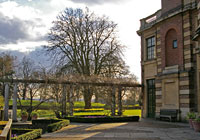 Once again the Gods shone their light on yet another break!
It may have been very cold but the sunshine made it a near perfect few days.
Once again the Gods shone their light on yet another break!
It may have been very cold but the sunshine made it a near perfect few days.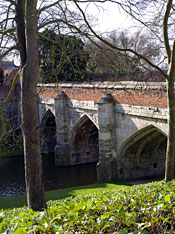
Local people seldom seem to visit where they live (which is true about me & Blackpool as least) so a recommendation to visit Eltham Palace seemed interesting, as it was the home of the textile magnates Sir Stephen and Lady Virginia Courtauld. Courtaulds had one of their filament yarn factories in my area and I thought it might be nice to see the opulence that the sweat of Lancashire workers had bought Stephen & Virginia! They built their glamorous London showpiece by 1936 (only a few years before I was born), next to the remains of a medieval royal palace which was originally Henry VIIIís boyhood home. If you thought the current house you could see was big, you could see, from the map that was displayed, it was built in one corner of the original palace. It is said that Odo, Bishop of Bayeux and half-brother of William the Conqueror, is listed in the Domesday Book as owning the original manor of Eltham in 1086. The palace was given to Edward II in 1305 by the Archbishop of Durham and used as a royal residence from the 14th to the 16th century. According to one of many accounts, an incident at a dance here, inspired Edward III's foundation of the Order of the Garter.
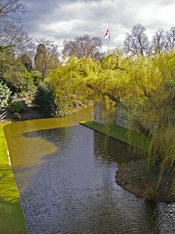
In 1933 Sir Stephen and Lady Virginia Courtauld acquired the lease of the palace site and restored the Great Hall while building an elaborate home, internally in the Art Deco style. They had huge connections with the film industry & the information boards said the interior of the Great Hall was Hollywood meets the Tudors, impressive nevertheless. Many films and television programmes have been filmed at Eltham Palace, including Brideshead revisited and The Antiques Road Show.
Stephen was the younger brother of industrialist and art collector Samuel Courtauld, founder of the Courtauld Institute of Art. He did not enter the family business but his wealthy background enabled him to travel extensively and to pursue cultural and philanthropic interests. Serving in the Artistsí Rifles during World War I. (Although it sounds like some kind of theatrical joke, they were in the thick of it in the Great War winning 8 Victoria Crosses, William Owen, Barnes Wallace & William Morris being amongst their officers). Courtauld won the Military Cross in 1918. After the war, in 1919, as an enthusiastic mountaineer, he completed the first ascent of the Innominata face of Mont Blanc in the French Alps. He married Virginia in 1923. The Courtaulds' had many strange pets but the pet ring-tailed lemur, called Mah-Jong, had a special room on the upper floor of the house which had a hatch to the downstairs flower room; he had the run of the house (known for nipping the ankles of servants & guests alike). The Courtaulds remained at Eltham until 1944 (during which time the roof of the Great Hall was badly damaged by a wartime bomb). In 1944 they moved to Scotland, giving the palace to the Royal Army Educational Corps in March 1945; the corps remained there until 1992.
As usual, there was no inside photography which is
always a pain but the grounds where stunning! Spring was here & the daffodils
were that chrome yellow that always comes with the sunshine, after winter's
gloom. The moat looks more like a very orderly river now. English Heritage
take such good care of the gardens, walking round in the sunshine gave a photo
opportunity at every corner.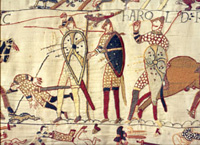
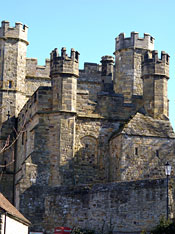 The
connection to the Domesday Book and 1066 and all that, came the next day
at Battle in East Sussex. There isn't a person in the land who hasn't had 1066,
Harold, with an arrow in the eye & William the Conquer branded into their brain.
And here, in an upper middle class English town that grew from the actual site of
the Battle of Hastings, you can still see the field itself. (As it's England, it's 6 miles from Hastings!). You can
stand on the very spot where King Harold allegedly died, explore the ruins of the
atmospheric abbey, built by William the Conquer to commemorate the thousands who
fell there and walk along a beautiful terrace that over looks the battle field. In
the museum, you can
grasp just how long ago it happened. There is a series of graphics that show the
time line back in 100 year blocks. 942 years have passed since the fate of this
country was completely changed.
The
connection to the Domesday Book and 1066 and all that, came the next day
at Battle in East Sussex. There isn't a person in the land who hasn't had 1066,
Harold, with an arrow in the eye & William the Conquer branded into their brain.
And here, in an upper middle class English town that grew from the actual site of
the Battle of Hastings, you can still see the field itself. (As it's England, it's 6 miles from Hastings!). You can
stand on the very spot where King Harold allegedly died, explore the ruins of the
atmospheric abbey, built by William the Conquer to commemorate the thousands who
fell there and walk along a beautiful terrace that over looks the battle field. In
the museum, you can
grasp just how long ago it happened. There is a series of graphics that show the
time line back in 100 year blocks. 942 years have passed since the fate of this
country was completely changed.
The French may have won but 900 years later, we are only just getting used to eating garlic.
The Abbey looks more like a castle from the outside. Inside they have preserved the tranquillity of a monastery that William had built but there is no doubt about the moving experience that still lingers around the battle field itself. If there are ghosts, this is a spot that they would walk. Lovers of myths & mysteries still claim that on the 14th October, when it rains, the battle ground weeps blood and a headless horseman still rides there. There is a massive website devoted to this place. The hours of work & the depth of knowledge contained is very impressive.
Briefly, the battle took place at
Senlac Hill,
approximately 6 miles
north-west of
Hastings,
the place on which the
abbey was
subsequently built.
The battle took place on
14 October
1066,
between the Norman army of
Duke
William of Normandy
from France, and the English army led by
King
Harold II.
Harold was killed during the battle; traditionally, it is believed he was shot
through the eye with an arrow. A plaque that shows where he succumbed to his 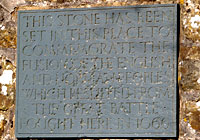 wounds,
became the location for the abbey's high alter. Although there was further English resistance for
some time to come, this battle is seen as the point at which William gained
control of England. Though the casualties figures are not known accurately, it
seems that around 5,000 English and 3,000 Normans were killed during the battle.
This is from a population that may only have been one or two million people.
wounds,
became the location for the abbey's high alter. Although there was further English resistance for
some time to come, this battle is seen as the point at which William gained
control of England. Though the casualties figures are not known accurately, it
seems that around 5,000 English and 3,000 Normans were killed during the battle.
This is from a population that may only have been one or two million people.
The famous Bayeux Tapestry depicts the events before and during the battle and is annotated in Latin. A Victorian replica of the Tapestry is housed in its own gallery at the Museum of Reading, the original (20 inches x 230 feet) is in it's only special museum in Bayeux in Normandy France.
After the moving experience of the battle field, travelling south though the rather tatty outskirts of Hastings, brings it home the fact that not all of England is inspiring or worth a visit. At least the sea at Hastings provides the ozone to change the air in your lungs, I have never got used to the pebbly beaches on the part of our coast. At least you can hear the sea at a louder volume!
Links for
information on this page:
